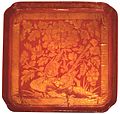File:Red lacquer tray with gold engraving, Song Dynasty.jpg
外觀

預覽大小:633 × 600 像素。 其他解析度:253 × 240 像素 | 507 × 480 像素 | 811 × 768 像素 | 1,081 × 1,024 像素 | 2,060 × 1,952 像素。
原始檔案 (2,060 × 1,952 像素,檔案大小:2.2 MB,MIME 類型:image/jpeg)
檔案歷史
點選日期/時間以檢視該時間的檔案版本。
| 日期/時間 | 縮圖 | 尺寸 | 使用者 | 備註 | |
|---|---|---|---|---|---|
| 目前 | 2008年9月18日 (四) 09:43 |  | 2,060 × 1,952(2.2 MB) | Yug | image improvements |
| 2008年6月30日 (一) 19:33 |  | 3,072 × 2,304(3.34 MB) | PericlesofAthens | {{Information |Description=A Chinese red lacquer tray over wood with engraved golden foil, from the Song Dynasty (960–1279 AD), dated 12th to early 13th century. In China, the gold-engraving technique is called ''qiangjin''. It has existed since rou |
檔案用途
下列2個頁面有用到此檔案:
全域檔案使用狀況
以下其他 wiki 使用了這個檔案:
- bo.wikipedia.org 的使用狀況
- en.wikipedia.org 的使用狀況
- fr.wikipedia.org 的使用狀況
- id.wikipedia.org 的使用狀況
- is.wikipedia.org 的使用狀況
- it.wikipedia.org 的使用狀況
- ml.wikipedia.org 的使用狀況
- nl.wikipedia.org 的使用狀況
- pl.wikipedia.org 的使用狀況
- ro.wikipedia.org 的使用狀況
- ru.wikipedia.org 的使用狀況
- sk.wikipedia.org 的使用狀況
- th.wikipedia.org 的使用狀況
- uk.wikipedia.org 的使用狀況
- vi.wikipedia.org 的使用狀況



